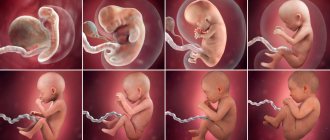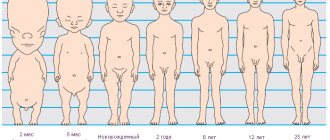When talking about the characteristics of infants, it should be taken into account that a newborn baby was born at full term. Now that modern neonatology has reached the most advanced level, doctors are caring for even those babies who were born much earlier than expected, with critically low body weight. This material will discuss the anatomical and physiological characteristics of newborn children: this information will be especially useful for young parents and those who are just thinking about the future expansion of their family.
A newborn child not only looks different from an adult, but also has many differences from him in the structure and functioning of various organs and systems. Over time, these differences smooth out.
A newborn is considered a child from birth to 4 weeks. Newborns are full-term, premature and post-term. Full-term babies are born between the 38th and 42nd weeks of pregnancy, premature babies - from the 28th to 38th week of pregnancy, post-term babies - after the 42nd week of pregnancy.
What does a newborn baby look like, born on time, and how does a baby who did not want to stay in the mother’s womb differ from him?
Average weight, body length and other external signs of a full-term newborn baby
Include Me shortcode: file not found
A healthy full-term newborn baby is already prepared for life. To determine his viability, immediately after his birth, doctors conduct an examination and determine several basic indicators.
The normal body weight of a healthy full-term newborn is from 2500 to 4500 g, the average weight is 3400 g. The normal body length is from 46 to 56 cm, the average body length of a full-term newborn is 50 cm. The normal head circumference is considered to be from 32.8 to 37.3 cm, average - 35 cm.
Some results obtained at birth may change. For example, weight may decrease the very next day, the loss will be up to 10% of birth weight.
Head circumference, on the contrary, can increase, since during the birth process the skull bones partially overlap each other to facilitate the passage of the child through the birth canal, and after birth they move into the right place.
A newborn has a certain set of innate reflexes that help him feed and navigate the world around him.
Also, external signs of a full-term newborn baby are the ability from the first days of life to focus his gaze on a stationary object, move his arms and legs well, quickly find and actively suck the breast. In general, during the newborn period (the first month of life), the child gains an average of 600-800 g in weight and grows by 3-4 cm. By the end of the month, he is awake up to 4-5 hours a day, fixes his gaze on objects well, and tries to smile; lying on his tummy, raises his head. This skill must be trained by placing it on the stomach for a few minutes before each feeding. For further harmonious development, you need to talk kindly to the baby during periods of wakefulness, and sing children's songs. At the same time, you can walk around the room so that he learns to follow moving objects. It is recommended to buy him large, bright, but not colorful rattles and hang them above the crib at a distance of about 70 cm from the baby’s chest so that he looks at them and tries to reach them.
These photos show what a newborn baby looks like when born at term:
Heat balance disturbances
Heat balance disturbances
occur in
newborns
due to imperfect regulation processes and instability of ambient temperature.
Newborns
easily overheat and cool down under environmental conditions that are not comfortable for them. Normally, a newborn’s temperature is 37-37.2 °C, and in the first days – 38-39 °C (due to a lack of water entering the body).
The main features of the process of thermoregulation in infants
are:
- The ability of children
to easily lose heat under uncomfortable conditions (lower ambient temperature, wet diapers); - Reduced ability to transfer heat when the ambient temperature rises (for example, when wrapping a child
, placing the crib in close proximity to a radiator or in direct sunlight).
All this leads to the fact that in the first 30 minutes after birth the child
the process of decreasing body temperature begins.
To prevent hypothermia, immediately after emerging from the birth canal the baby
is wrapped in a sterile diaper, carefully dried and placed on a heated changing table.
Considering the above features of newborn babies
, it is necessary to maintain a comfortable ambient temperature (for a full-term
baby
this is 20–22°).
In this case, it is necessary to avoid possible overheating. Since very rarely, in 1% of children
, temporary hyperthermia may develop on days 3–5—an increase in body temperature to 38–39°.
Hormonal (sexual) crisis
in newborns
is associated mainly with the effect of mother's hormones on
the child
and occurs in full-term
newborns
.
These conditions are quite rare
in premature babies Sexual crisis
includes several conditions:
- Breast engorgement
, which begins on days 3–4 of life, reaches a maximum on days 7–8 and then gradually decreases.
Sometimes a milky-white discharge is observed from the mammary gland, which in composition is close to the mother’s colostrum. Breast enlargement occurs in most girls and half of boys. You should not put pressure on the mammary glands, massage them, or even try to express drops of liquid from the nipples. Any manipulation of the mammary glands in infants
is dangerous because it can lead to the development of
neonatal
mastitis , and this is a very serious disease and can only be treated surgically.
For prevention, it is enough to simply make a pad of cotton wool and gauze and place it on the mammary glands under the baby’s
. In case of severe engorgement, the pediatrician will prescribe special compresses; - Milia
are whitish-yellow nodules 1–2 mm in size, rising above the skin level, most often localized on the wings of the nose and bridge of the nose, in the forehead and chin.
These are sebaceous and sweat glands with copious secretions and clogged ducts. Occurs in 40% of newborns
and does not require treatment; - Hydrocele of the testicular membranes (hydrocele)
- occurs in 5-10% of boys, goes away without treatment during the neonatal period;
Desquamative vulvovaginitis
- abundant grayish-white mucous discharge from the genital opening, appearing in 60–70% of girls in the first three days of life. The discharge lasts 1-3 days and then gradually disappears. The nature of vaginal discharge can also be bloody - this is not a cause for concern. This condition does not require therapy. If there is vaginal discharge, the girl should be washed with a light pink, cool solution of potassium permanganate from front to back.
NEWBORN ACNE (estrogenic acne)
- appear in the first 3-5 months.
life of a child
, being a reaction of small, superficially located sebaceous glands
of newborns
to the sex hormones of the mother (usually having a history of severe manifestations of acne).
The rashes are few in number, represented by open and closed (milium) comedones, small papules and pustules with a small inflammatory halo around. Elements of acne are isolated, localized on the skin of the cheeks, forehead, nose, nasolabial and nasolabial folds, on the back of the head, sometimes on the skin of the penis . A few days after the onset of acne in newborns
, it resolves on its own.
Signs of a premature newborn baby
A premature newborn is considered a child who was born between the 28th and 37th weeks of development, with a body weight of 1000-2500 g and a height of 35-46 cm. The earlier the baby was born before the due date, the more noticeable its differences from a full-term baby .
The causes of prematurity can be the birth of twins, the mother's age is less than 18 and more than 35 years, her malnutrition and diseases, including infectious (syphilis, herpes, cytomegalovirus infection, even ARVI and influenza), stress, occupational hazards, alcohol abuse and smoking, fetal malformations, various intrauterine diseases of the fetus, pregnancy pathology, toxicosis.
At first, premature babies differ quite noticeably from full-term babies both in appearance and in functional characteristics.
What do premature babies look like when they are born? External signs of a premature newborn are:
1. In premature infants, the layer of subcutaneous fat is less developed or completely absent, so these babies look very thin, sometimes looking like wrinkled old men.
2. One of the anatomical and physiological features of premature newborns is a disproportionately large head with too short and thin legs. The fact is that at the stage of pregnancy when the baby is born, all children look exactly like this. This is one of the stages of normal fetal development.
3. The cerebral part of the skull is larger than the facial part , the large fontanel is large, the sutures between the bones of the skull are open.
4. Thick vellus hair covers the entire surface of the body, and even the face.
5. Another feature of premature newborns is soft, pliable ears, tightly pressed to the skull.
6. In girls, the labia majora do not completely cover the genital opening; in boys, the testicles are not lowered into the scrotum.
There are significant differences in the functioning of various organs and systems of the body of a premature baby, associated with their insufficient maturity. The severity of these signs of a premature baby depends on the stage of pregnancy at which the baby was born. Of particular importance when caring for a premature baby is the immaturity of the respiratory, digestive and thermoregulation systems. Due to these differences, there are some features of home care for premature babies. If a child is born very premature, then after birth he is placed for nursing in a special chamber - an incubator. It maintains a certain temperature and humidity, simulating intrauterine conditions. The baby is fed in a special regime, protected from infection, and thus he grows and develops until he can exist under normal conditions. The length of stay in the incubator depends on the degree of prematurity and the general condition of the baby. The strongest ones stay there from several hours to 2-4 days. Babies with a birth weight of less than 1500 g are nursed in an incubator for 8-14 days, and from 1500 to 1750 g - 8 days. After this, they are transferred to the premature ward. Children weighing more than 2000 g are observed longer in the maternity hospital in special departments, and if they feel normal, they are sent home.
Look at the photo of what premature babies born prematurely look like:
AFO of the skin and subcutaneous tissue in a newborn baby
At the moment of birth, the skin of a newborn baby is covered with a thick layer of a special substance - the so-called cheese-like lubricant, which consists mainly of fat and cholesterol. This lubricant performs a protective function and makes childbirth somewhat easier.
The thickness of a baby's skin is much less than that of an adult. It is so thin and so rich in small blood vessels that it appears transparent and pinkish.
It is lighter, which is due to the insufficient production of pigment - melanin. The skin of a newborn is very vulnerable to external adverse influences and pathogens. However, already during the first month of life, the skin becomes resistant to adverse external influences.
The skin performs a protective function for the entire body, however, due to its structural features, this function is less pronounced. A child's skin is more vulnerable and easily becomes infected when bacteria penetrate through microdamages. A baby's skin often develops diaper rash, abrasions from excess moisture (soaked diapers, too warm clothes) and too rough clothing.
In addition, in newborns the role of the skin as a sensory organ is very important. After all, it is through the contact of the baby’s skin with the mother’s body that a close relationship is formed between them, and the baby recognizes his mother. Newborn babies breathe very intensely through their skin and secrete a fairly large volume of metabolic products. Therefore, it is very important to take care of your baby’s skin, keep it clean and healthy.
The subcutaneous fatty tissue of a newborn baby also has its own characteristics. Its amount occupies a larger proportion of the total body weight than in an adult. This is necessary for the child’s body to protect against unfavorable external conditions, including hypothermia.
By the time of birth, subcutaneous fat is predominantly distributed on the chest, back, limbs and face. The anatomical and physiological characteristics (APF) of the skin and subcutaneous tissue in newborns is that they are partially represented by the so-called brown adipose tissue. When it burns in the body during the metabolic process, a large amount of heat is generated, which is necessary to warm the baby’s body.
With age, the composition and distribution of adipose tissue in the body changes, gradually approaching those of an adult.
A newborn's hair has the appearance of a delicate fluff, sometimes covering the entire body. During the first month of life, these hairs fall out and are replaced by permanent ones.
AFO of the musculoskeletal system in newborns
The musculoskeletal system of newborns also has its own anatomical and physiological characteristics (AFP): the mass of muscle tissue of an infant in relation to the total body weight is significantly less compared to an adult. Its distribution in the body is also special: most of the muscle tissue is in the muscles of the trunk, the smaller part is in the muscles of the limbs. Therefore, a newborn baby appears to be a creature with a very large belly and head and thin arms and legs. Gradually, this ratio of the musculoskeletal system in newborns changes, the muscles of the limbs are trained, and the body structure approaches that of an adult.
In newborns, the tone of the muscles that flex the limbs is increased, so at first their arms and legs are predominantly in a bent state, the child, as if out of habit, maintains the intrauterine position.
The neck muscles are practically not developed at first, so the newborn cannot hold his head. The movements of the arms and legs are erratic and sweeping.
The bone tissue of a newborn contains a small amount of salts, so the baby’s bones are fragile, flexible and easily bent if not properly cared for.
During the first year of life, the structure of bone tissue changes completely, so during this period it is very sensitive to eating disorders, physical activity, and muscle tone of the child.
A feature of the baby’s skull is the presence of fontanelles - non-ossified areas of the skull. There are two main fontanelles and several small ones. The main ones include the anterior (large) and posterior (small) fontanel. The large fontanel is located above the child's forehead, at the junction of the frontal and parietal bones. It has the shape of a diamond and measures from 1.5 x 2 to 3 x 3 cm and closes completely by 1-1.5 years. The small fontanelle is located in the occipital region at the junction of the parietal and occipital bones. It has the shape of a triangle and closes in the 1st-2nd month of the baby’s life.
The spine of a newborn is straight and does not have the physiological bends characteristic of the spine of an adult. The cervical curve forms after the child begins to hold his head up. The thoracic curve begins to form at 6-7 months, when the child can already sit. The lumbar spine begins to develop from 9-12 months, when the child learns to walk. In general, the formation of the spine ends around the age of 20.
AFO and features of the respiratory and nervous system of a newborn
The respiratory system of a newborn, like all others, is imperfect. The nose of a newborn baby is small, its cavities are underdeveloped, and the nasal passages are narrow. The nasal mucosa is very thin, delicate, rich in blood vessels, and therefore, with various viral respiratory infections (ARVI), the nasal mucosa quickly becomes swollen, a large amount of mucus is released, which makes it even more difficult for the baby to breathe. One of the features of the respiratory system of a newborn baby is that the vocal cords are too short, so babies’ voices are usually high-pitched.
The child's breathing is shallow and occurs mainly through the diaphragm, since the intercostal muscles, which raise and lower the ribs during breathing, are not yet sufficiently developed. Due to the anatomical and physiological characteristics (APP) of the respiratory system of a newborn, the child’s breathing is easily disrupted. This can also be caused by too tight swaddling, constipation, and accumulation of gases in the intestines, as these phenomena limit the mobility of the diaphragm.
In addition, a newborn's breathing is more frequent - about 40-60 respiratory movements per minute, and the frequency increases even more with the slightest load and with illness. Considering the characteristics of the respiratory system of a newborn baby, try to minimize the risk of colds.
The nervous system is not yet mature enough at the time of birth. The nerve centers of the brain are well developed and are responsible for the functioning of the cardiovascular, respiratory, and digestive systems, i.e., ensuring the existence of a newborn child. The centers of higher nervous activity (speech, writing, thinking) are practically absent. The nervous system of a newborn provides unconditioned innate reflexes, and already from the second week of life it participates in the formation of conditioned reflexes.
Remember: a baby's cry does not always mean dissatisfaction, but almost always a need. After all, only in contact with other people does a child feel comfortable. If they communicate with him, take him in their arms, talk, do something for him, it means they love him.
AFO and features of the cardiovascular and immune system of the newborn
Include Me shortcode: file not found
The cardiovascular system of a newborn also has its own characteristics. The ratio of heart weight to body weight in a newborn is slightly greater than in an adult. The heart in newborns is located higher in the chest and almost horizontally. Its shape is spherical, whereas in adults it is more like a drop. Due to the characteristics of the cardiovascular system, a newborn’s pulse is much higher than that of an adult, which is primarily due to a more intense metabolism in the child’s body.
In the first months of a baby’s life, his pulse rate is 120-140 beats per minute, and when feeding and crying it increases to 160-200 beats. After the child begins to walk actively and a lot, the heart rate decreases noticeably.
Due to the anatomical and physiological characteristics (APP) of the newborn’s cardiovascular system, the infant’s blood pressure in the first days of life averages 66/36 mmHg. Art., and by the end of the first month of life - 80/45 mm Hg. Art. Then, during the 2-3rd year of the child’s life, the value of his blood pressure increases most significantly.
The immune system. The fetus receives some immunity factors through the mother's blood, some - with colostrum or produces it itself. With good care, the child does not get sick for the first six months of life, as he is protected by maternal antibodies. However, when encountering strong pathogens or health problems, the baby gets sick, since in general his immune system is still imperfect.
Physiological catarrh of the skin (transient erythema of the skin).
Appears as:
1. simple erythema
2. toxic erythema
SIMPLE erythema.
This is reactive redness of the skin (sometimes with a slight bluish tint to the hands and feet).
CAUSE:
reflex paretic dilatation of skin vessels due to the powerful influence of environmental factors on the receptors of the newborn’s skin.
Appears first
days of life, in mature full-term babies it lasts several hours, less often 1 – 2 – 3 days.
TOXIC erythema
.
This is a kind of allergic reaction of the skin of a newborn.
Occurs on days 2–5 of life
. It appears as a rash - hyperemic spots, papules, vesicles on the entire skin, except the palms and soles. Disappears after 2 – 3 days. After erythema, fine peeling occurs, sometimes large.
TACTICS of a midwife (nurse, paramedic):
Skin care
Hygienic bath with potassium permanganate solution
AFO and features of the digestive system in newborns
Many organs of the newborn's digestive system are not yet sufficiently developed at the time of birth. At the same time, it bears a very heavy load due to the high metabolism in the child’s body. Therefore, even minor violations of the diet and nutrition of a breastfeeding mother lead to digestive upset in the baby.
A newborn's tongue is relatively large. In general, the structure of its oral cavity is adapted for sucking: on the surface of the lips there are small elevations, the so-called pads, and in the thickness of the cheeks there are special accumulations of adipose tissue - Bish’s lumps. One of the features of the digestive system in newborns is the underdevelopment of the salivary glands, so at first the child produces very little saliva.
The muscles that cover the junction of the esophagus and the stomach are not sufficiently developed, which is why babies often regurgitate. In order to avoid them, it is recommended after feeding to hold the baby for 15-20 minutes in an upright position, leaning his head against the mother’s chest. The stomach is also underdeveloped at the time of birth. On the first day of a child’s life, its capacity is only 7 ml, on the 4th day it increases to 40-50 ml, and by the 10th day it is already 80 ml.
Another anatomical and physiological feature (APF) of the digestive system of a newborn child is insufficient development of the large intestine, especially the muscles of its wall. Therefore, food moves through it slowly, and newborns are often tormented by the accumulation of gases in the intestines and bloating - flatulence. Children often experience constipation for the same reason.
In the first 1-3 days of a child’s life, his stool is quite specific. It is called “meconium” and consists mainly not of food, but of amniotic fluid, mucus, and bile that entered the stomach and intestines before birth. It is a viscous, dirty green, odorless mass.
The appearance of meconium is a very important sign of the correct formation and patency of the gastrointestinal tract and is assessed by doctors in the maternity hospital.
If meconium does not appear within this period, it means that the child has a malformation of the gastrointestinal tract, requiring immediate surgical intervention.
In the first days of life, the newborn’s intestines are populated with digestive microflora, the functioning of the digestive glands is improved, and the nature of the stool changes. Now it is a yellowish mass consisting of saliva, digestive juices and food debris. The peculiarity of the digestive system of a newborn baby is such that when breastfeeding, the baby’s stool has virtually no odor.
Physiological (transient hyperbilirubinemia) jaundice.
CAUSES:
Immaturity of liver enzyme functions
Massive destruction of fetal red blood cells (there are many of them in the fetus)
Increased levels of bilirubin in the blood
Red blood cell pigment accumulates in the skin and mucous membranes and turns yellow
Appears on 2–3 days
, maximum for 4-5 days.
Disappears by 7-10 days of life
.
SIGNS:
jaundiced discoloration of the skin and mucous membranes without affecting health.
TACTICS of a midwife (nurse, paramedic):
Additional drinking of 5% glucose solution
Monitoring the child's condition
Other features of newborn babies
Genitourinary system. By the time a child is born, his kidneys, ureters and bladder are quite well formed, although small in size, but during birth the child experiences stress, which leads to a decrease in the functioning of the urinary system in the first days of life.
One of the physiological features of a newborn is that during the first week of life the child urinates only 5-6 times a day. From the second week, the state of the urinary system gradually returns to normal, and the number of urinations is already 20-25 per day, the volume of urine excreted is small due to the small volume of the bladder.
The external genitalia are formed. A sign of a full-term newborn boy is the descent of the testicles into the scrotum at the time of birth; in girls, the labia majora cover the labia minora.
Sense organs. In the first days, the newborn's vision, hearing and smell almost do not work. During this period, the child experiences the world only through touch, taste and temperature sensitivity. In the first 2 months, the baby does not produce tear fluid, so the newborn cries without tears.
Hematopoiesis. The formation of new blood cells in a newborn occurs very actively. In him, as in adults, the main hematopoietic organ is the red bone marrow. In addition, in the body of a newborn there are several additional foci of hematopoiesis - the liver, spleen and lymph nodes. Due to this function, the spleen is quite large.
Metabolism. One of the features of a newborn baby is a very intense metabolism. Infants have an increased need for carbohydrates as a source of energy, as well as for fats. The need for fluid is also high, which in the first months of life is fully satisfied by consuming mother's breast milk or artificial nutritional formulas.
3. Physiological (transient) fever.
CAUSES:
Imperfection of thermoregulation
Insufficient amount of fluid entering the body
Unstable water exchange
Child overheating
Entry of endotoxins from Escherichia coli during the initial colonization of the intestine
Appears on days 3–5 of life.
Disappears after a few hours or 1 – 2 days.
SIGNS:
T 38-39 degrees, anxiety, thirst, dry skin and mucous membranes.
TACTICS of a midwife (nurse, paramedic):
Reveal the child
Monitoring body temperature and condition










